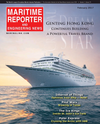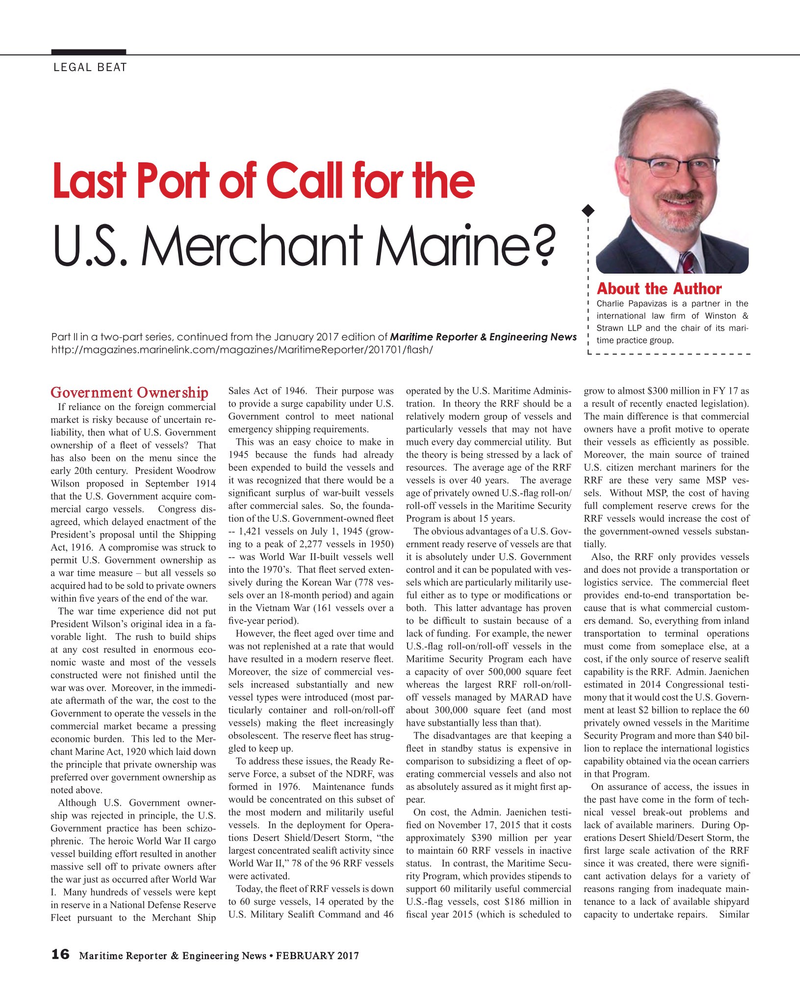
Page 16: of Maritime Reporter Magazine (February 2017)
The Cruise Industry Edition
Read this page in Pdf, Flash or Html5 edition of February 2017 Maritime Reporter Magazine
LEGAL BEAT
Last Port of Call for the
U.S. Merchant Marine?
About the Author
Charlie Papavizas is a partner in the international law ? rm of Winston &
Strawn LLP and the chair of its mari-
Part II in a two-part series, continued from the January 2017 edition of Maritime Reporter & Engineering News time practice group.
http://magazines.marinelink.com/magazines/MaritimeReporter/201701/? ash/
Sales Act of 1946. Their purpose was operated by the U.S. Maritime Adminis- grow to almost $300 million in FY 17 as
Government Ownership
If reliance on the foreign commercial to provide a surge capability under U.S. tration. In theory the RRF should be a a result of recently enacted legislation).
Government control to meet national relatively modern group of vessels and The main difference is that commercial market is risky because of uncertain re- liability, then what of U.S. Government emergency shipping requirements. particularly vessels that may not have owners have a pro? t motive to operate
This was an easy choice to make in much every day commercial utility. But their vessels as ef? ciently as possible. ownership of a ? eet of vessels? That has also been on the menu since the 1945 because the funds had already the theory is being stressed by a lack of Moreover, the main source of trained early 20th century. President Woodrow been expended to build the vessels and resources. The average age of the RRF U.S. citizen merchant mariners for the
Wilson proposed in September 1914 it was recognized that there would be a vessels is over 40 years. The average RRF are these very same MSP ves- signi? cant surplus of war-built vessels age of privately owned U.S.-? ag roll-on/ sels. Without MSP, the cost of having that the U.S. Government acquire com- after commercial sales. So, the founda- roll-off vessels in the Maritime Security full complement reserve crews for the mercial cargo vessels. Congress dis- agreed, which delayed enactment of the tion of the U.S. Government-owned ? eet Program is about 15 years. RRF vessels would increase the cost of
President’s proposal until the Shipping -- 1,421 vessels on July 1, 1945 (grow- The obvious advantages of a U.S. Gov- the government-owned vessels substan-
Act, 1916. A compromise was struck to ing to a peak of 2,277 vessels in 1950) ernment ready reserve of vessels are that tially.
permit U.S. Government ownership as -- was World War II-built vessels well it is absolutely under U.S. Government Also, the RRF only provides vessels a war time measure – but all vessels so into the 1970’s. That ? eet served exten- control and it can be populated with ves- and does not provide a transportation or sively during the Korean War (778 ves- sels which are particularly militarily use- logistics service. The commercial ? eet acquired had to be sold to private owners sels over an 18-month period) and again ful either as to type or modi? cations or provides end-to-end transportation be- within ? ve years of the end of the war.
The war time experience did not put in the Vietnam War (161 vessels over a both. This latter advantage has proven cause that is what commercial custom- ? ve-year period). to be dif? cult to sustain because of a ers demand. So, everything from inland
President Wilson’s original idea in a fa-
However, the ? eet aged over time and lack of funding. For example, the newer transportation to terminal operations vorable light. The rush to build ships was not replenished at a rate that would U.S.-? ag roll-on/roll-off vessels in the must come from someplace else, at a at any cost resulted in enormous eco- nomic waste and most of the vessels have resulted in a modern reserve ? eet. Maritime Security Program each have cost, if the only source of reserve sealift constructed were not ? nished until the Moreover, the size of commercial ves- a capacity of over 500,000 square feet capability is the RRF. Admin. Jaenichen sels increased substantially and new whereas the largest RRF roll-on/roll- estimated in 2014 Congressional testi- war was over. Moreover, in the immedi- ate aftermath of the war, the cost to the vessel types were introduced (most par- off vessels managed by MARAD have mony that it would cost the U.S. Govern- ticularly container and roll-on/roll-off about 300,000 square feet (and most ment at least $2 billion to replace the 60
Government to operate the vessels in the commercial market became a pressing vessels) making the ? eet increasingly have substantially less than that). privately owned vessels in the Maritime obsolescent. The reserve ? eet has strug- The disadvantages are that keeping a Security Program and more than $40 bil- economic burden. This led to the Mer- gled to keep up. ? eet in standby status is expensive in lion to replace the international logistics chant Marine Act, 1920 which laid down
To address these issues, the Ready Re- comparison to subsidizing a ? eet of op- capability obtained via the ocean carriers the principle that private ownership was serve Force, a subset of the NDRF, was erating commercial vessels and also not in that Program.
preferred over government ownership as formed in 1976. Maintenance funds as absolutely assured as it might ? rst ap- On assurance of access, the issues in noted above.
would be concentrated on this subset of pear. the past have come in the form of tech-
Although U.S. Government owner- ship was rejected in principle, the U.S. the most modern and militarily useful On cost, the Admin. Jaenichen testi- nical vessel break-out problems and vessels. In the deployment for Opera- ? ed on November 17, 2015 that it costs lack of available mariners. During Op-
Government practice has been schizo- phrenic. The heroic World War II cargo tions Desert Shield/Desert Storm, “the approximately $390 million per year erations Desert Shield/Desert Storm, the vessel building effort resulted in another largest concentrated sealift activity since to maintain 60 RRF vessels in inactive ? rst large scale activation of the RRF massive sell off to private owners after World War II,” 78 of the 96 RRF vessels status. In contrast, the Maritime Secu- since it was created, there were signi? - the war just as occurred after World War were activated. rity Program, which provides stipends to cant activation delays for a variety of
Today, the ? eet of RRF vessels is down support 60 militarily useful commercial reasons ranging from inadequate main-
I. Many hundreds of vessels were kept to 60 surge vessels, 14 operated by the U.S.-? ag vessels, cost $186 million in tenance to a lack of available shipyard in reserve in a National Defense Reserve
Fleet pursuant to the Merchant Ship U.S. Military Sealift Command and 46 ? scal year 2015 (which is scheduled to capacity to undertake repairs. Similar 16 Maritime Reporter & Engineering News • FEBRUARY 2017
MR #2 (10-17).indd 16 MR #2 (10-17).indd 16 2/6/2017 9:48:28 AM2/6/2017 9:48:28 AM

 15
15

 17
17
